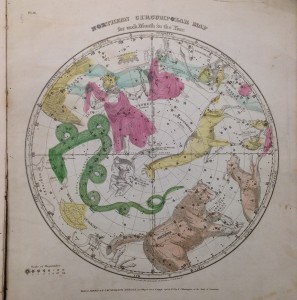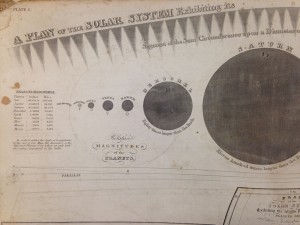Today’s solar eclipse over Europe brought to mind a unique atlas recently exhibited in our Exhibit Gallery here at the Indiana State Library. Elijah Burritt’s 1836 Atlas, Designed to Illustrate the Geography of the Heavens features beautiful hand-colored renderings of the celestial bodies as seen from the Northern Hemisphere at different times of the year.
It also includes a map of our known solar system, circa 1835. I stopped in my tracks, however, when I spotted a planet called “Herschel”.
This interesting find turned into a brief but amusing lesson in the history of the planet Uranus. Discovered by William Herschel (1738-1822) in 1781, discussion was still ongoing about what to call the new planet when this atlas was printed. While Hershel wanted to name the planetary discovery “the Gregorium Sidus” (or, “The Georgian Planet”) after King George III, others in Europe were likely not convinced they wanted to permanently name a planet after an English king. At the time this atlas was printed, Uranus was still being referred to as “Herschel” after the man who discovered it. It was not until the 1850s that the name Uranus, after the Greek god of the heavens, came into common use.
The General Collections of the Indiana State Library feature some unique and fantastic holdings from the history of art to zoology. If you have a unique or specialized area of research, please contact the Indiana State Library at (317)232-3678 or “Ask-A-Librarian” at http://www.in.gov/library/ask.htm. You might be surprised what you’ll find!
Information about Uranus sourced at NASA’s Solar System Exploration website: https://solarsystem.nasa.gov/planets/profile.cfm?Object=Uranus&Display=OverviewLong
This blog post was written by Rebecca Shindel, Conservator, Indiana State Library.


